Great Dane Dog Breed
The Great Dane is a majestic breed known for its towering size and noble demeanor. These dogs hail from Germany and were once used for hunting and protecting. Today, they’re cherished as loyal family pets. Despite their size, which can reach up to 32 inches at the shoulder, Great Danes are affectionately known as ‘Gentle Giants’ for their friendly disposition.
Owning a Great Dane means understanding the breed’s unique needs and possible health issues, which their large build can impact. It’s not just their impressive size; it’s also about knowing how to care for these canines properly. Their breed commands attention for their striking appearance and the special considerations required to live a healthy and fulfilling life.
Key Takeaways
- Great Danes are towering, friendly German dogs.
- They require special care due to their large size.
- These dogs are valued as loyal companions in homes.
Quick Facts
Great Danes stand out with their towering size, making them easily one of the most giant dog breeds. Males can grow up to 30-32 inches tall and weigh between 140-175 pounds, while females tend to be slightly smaller. They are often considered the tallest dogs and have a noble look, thanks to their strong muscles that hint at their past roles in hunting and protection. Despite their massive build, these dogs are known for their gentle and friendly nature, making them great pets for families and single owners.
The lifespan of a Great Dane is typically shorter than smaller breeds, usually around 7-10 years. They belong to the Working Group of Dogs and have evolved from their origins in Germany to become mostly loved for their companionship. Their large size does make them prone to specific health issues like bloat, heart problems, and joint complications. Owners must maintain their Great Dane’s health with regular vet visits to prevent and treat illnesses.
Their impressive size and friendly temperament continue to make them popular among dog lovers all over the globe.
Great Dane Breed Pictures
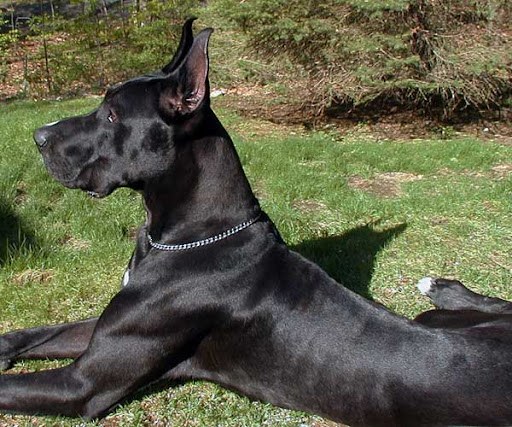
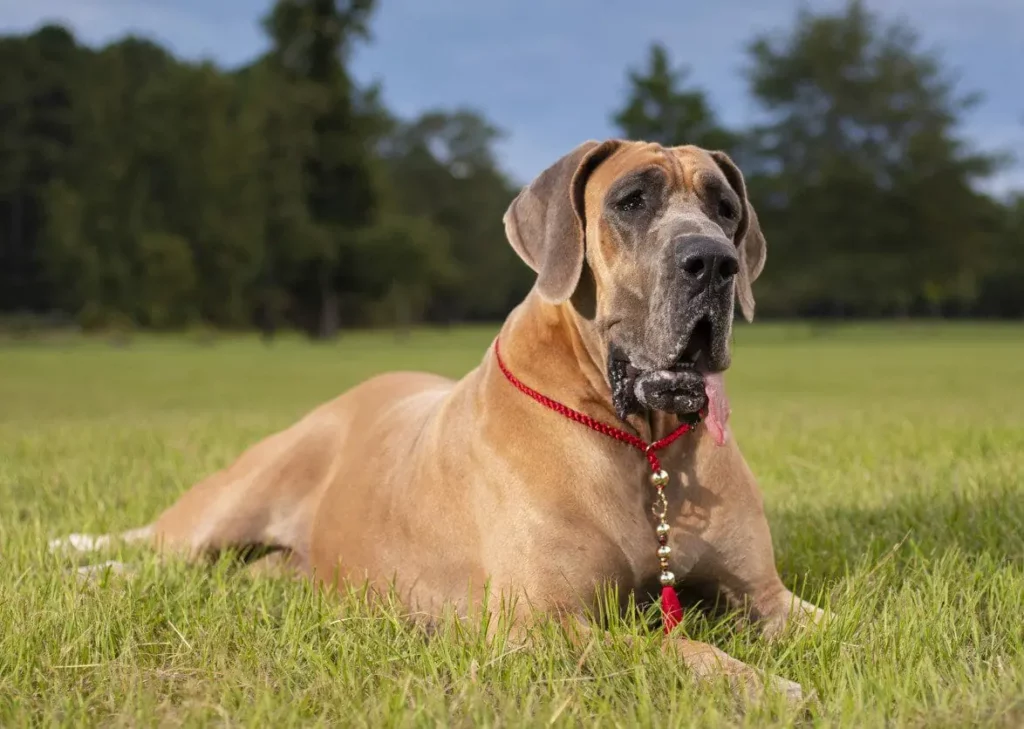
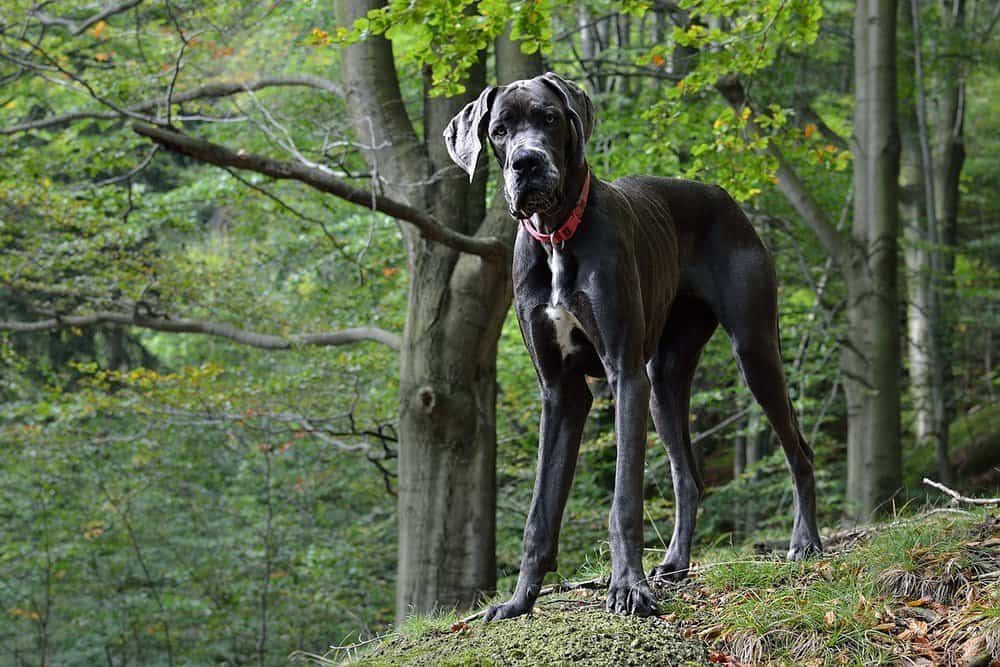

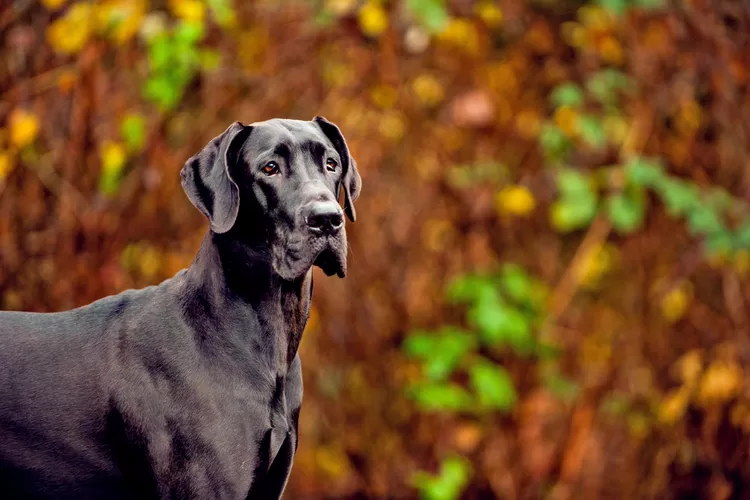
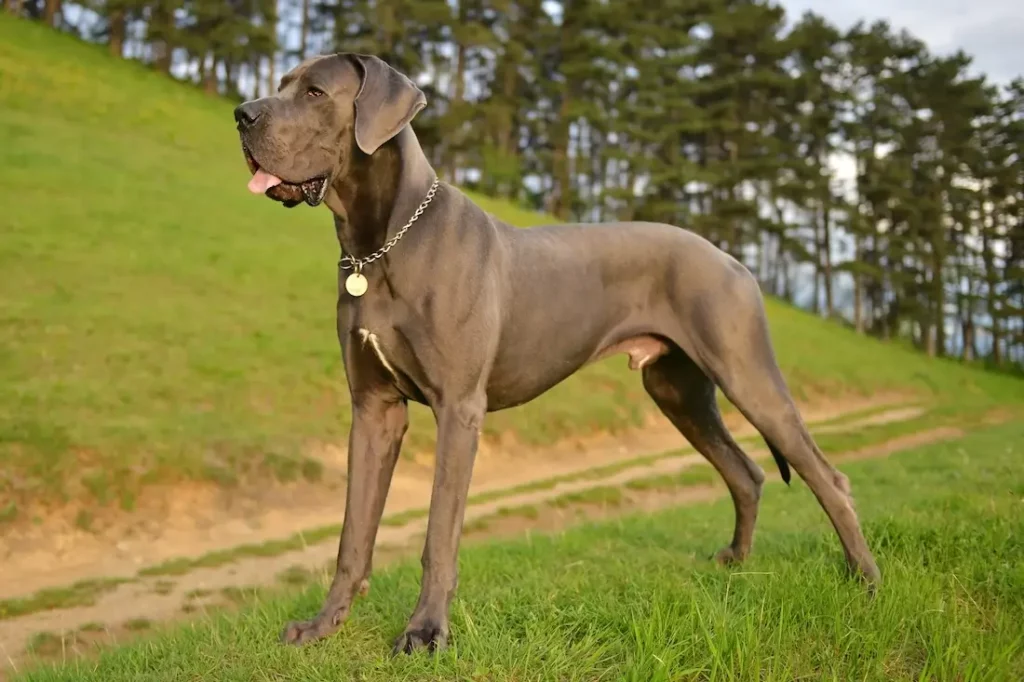
Overview of Great Danes
Despite their large size, great Danes are known for their gentle and loving nature. They make excellent pets for various homes due to their friendly behavior. Female Great Danes usually stand between 28 and 32 inches tall, and males are a bit larger, ranging from 30 to 34 inches. Their size doesn’t stop them from getting along well with humans and other animals.
Regarding their health, Great Dane puppies need extra attention as they are prone to certain conditions. These include a severe stomach condition called bloat, heart issues like cardiomyopathy, and hip dysplasia, which affects the hip joints. To keep them healthy, it’s crucial to have regular vet visits and monitor their diet closely.
Great Danes have a lifespan of about 7 to 10 years and do best when they have plenty of room to move around. They need an ample indoor space and a yard with a tall, secure fence to meet their exercise needs. These dogs are also known for their striking looks, with a broad square head and a short coat that comes in colors like black, fawn, brindle, blue-gray, harlequin, or mantle.
Great Dane Colors: Breed Hallmarks
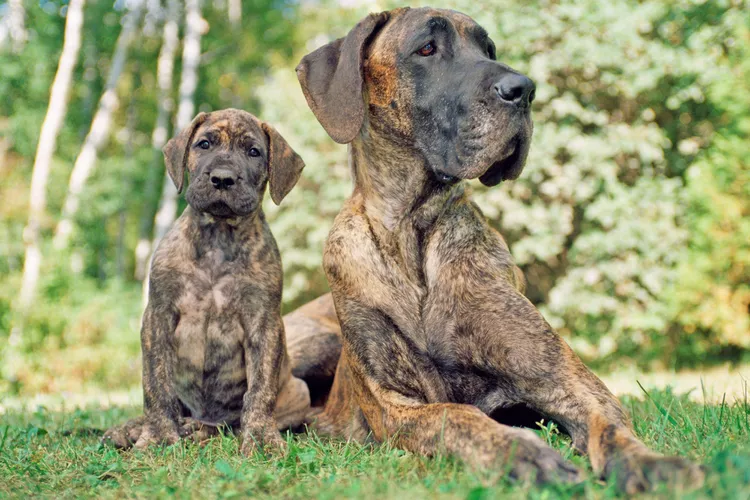
The Great Dane, hailing from Germany, is renowned for its towering presence and varied coat colors, which stem from its history with German hunting nobility. These dogs were valued for their ability to hunt and regal looks, including a black coat over the body and several recognized patterns.
The coat of a Great Dane showcases distinct colors and patterns, like the clown, which features a white background with black spots. These dogs are visually stunning and cherished for their friendly and loving nature. They are ideally suited as both family pets and working dogs.
Careful attention to the breed’s health and appearance standards is crucial due to their risk of specific health issues. Owners and breeders must be proactive with health care and consistent vet visits.
| Attribute | Description | Relevance |
|---|---|---|
| Size | 30-34 inches, 140-175 pounds | Shows their past role in hunting big game |
| Coat Colors | Fawn, brindle, black, harlequin, mantle, grey merle, blue | Suggests their noble heritage |
| Health Considerations | Susceptible to bloat, heart conditions, wobbler syndrome, hip dysplasia | Important for maintaining the breed’s health |
The characteristics of the Great Dane go beyond looks, intertwining with their historical significance and practical uses.
German Hunting Origins
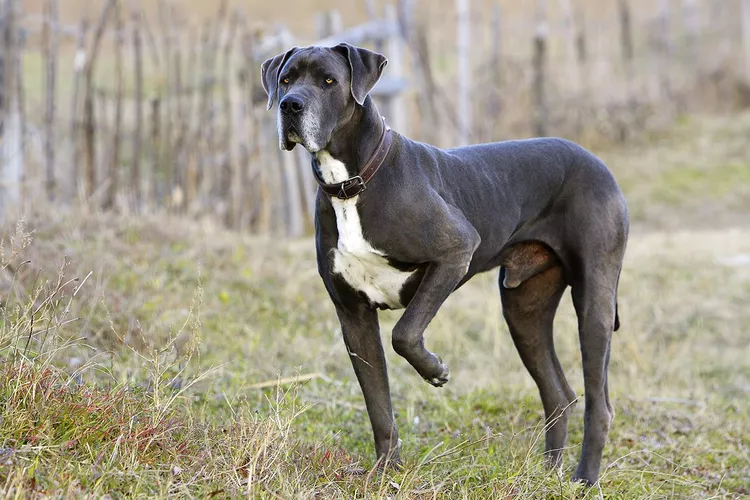
The Great Dane’s development into a unique breed is deeply entwined with Germany’s elite hunting circles. Their formidable size and strength made them indispensable for chasing and subduing large games. These dogs played a vital role in the hunt and served as a status symbol for the nobility. Here’s a closer look at their evolution:
- Breeders in Germany selectively mated these dogs to amplify traits functional in hunting big animals.
- Over time, the Great Dane became more of a luxury accessory for the wealthy than a hunting companion.
- German breeding techniques shaped the Great Dane’s stature and temperament, making them what they are today.
- As perceptions changed, the Great Dane transitioned from a hunter to a beloved family pet and a regular in dog shows.
These dogs were carefully bred to excel in hunting, eventually leading to the Great Dane’s impressive build and hunting capabilities. Their role gradually morphed from hunters to emblems of wealth and power.
German breeding methods have left a lasting mark on the breed’s physical form and behavior. Finally, the image of the Great Dane changed from a valuable hunting partner to a cherished companion and a favorite in dog exhibitions.
Breed Development History
Great Danes have a rich history as mighty hunters within the courts of German nobility. They were selectively bred for their impressive strength and quickness to track down challenging games like bears, wild boars, and deer.
These powerful dogs descended from hardy, long-legged breeds, specifically the crossbreeding of English Mastiffs and Irish Wolfhounds, known locally as Englische Docke or Englischer Hund. German breeders, fond of imposing canines, introduced bloodlines from Molossian hounds and other Greek dogs to enhance their stature and abilities.
Hunting Role Evolution
In the 1600s, the German aristocracy introduced strong, tall dogs from England to improve their hunting expeditions. These early ancestors of the Great Dane were skilled in tracking and hunt wild boar, earning them the name ‘Englische Docke’ or ‘Englischer Hund.’
Over time, the breed was refined with Molossian hound genes from Greece, leading to significant changes in their appearance. By 1878, they were known as the Deutsche Dogge.
As society began to value the character of dogs over their hunting abilities, the Great Dane transitioned from a hunter to a gentle family pet. This change mirrored a broader trend of viewing dogs more as companions than working animals.
The Great Dane’s journey from a mighty German boarhound to a friendly household member reflects this cultural shift.
Germanic Ancestry Influence
The Great Dane’s journey from an influential German boarhound to a beloved pet shows the strong influence of its Germanic roots and aristocratic hunting history.
Initially bred by German nobility, the Great Dane was created from a mix of German Mastiff and Irish Wolfhounds. These dogs, known then as’ Englische Docke’ or’ Englischer Hund,’ were prized for their prowess in hunting bears and wild boars during the 17th century.
The breed was further refined with the addition of Molossian hounds and other influential European breeds, securing the Great Dane’s reputation as a noble and imposing dog.
Amidst political changes, German breeders worked to establish a distinct identity for the breed, which led to its varied names in different languages.
Great Dane Personality
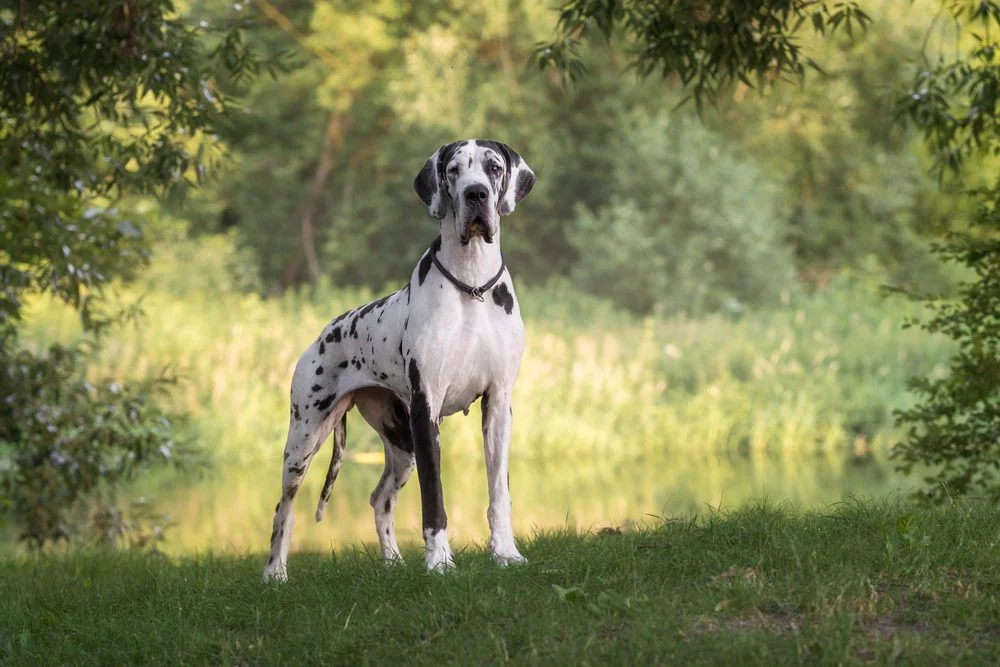
The Great Dane’s large size isn’t just for show; it’s central to their health and care. Understanding the impact of their vast build requires careful consideration of several factors:
- Their large bodies mean Great Danes need a special diet and healthcare plan different from smaller dogs.
- They’re prone to health issues common in large breeds, so prevention and catching problems early are critical.
- Exercise for these dogs should keep them fit without hurting their joints.
- They need plenty of room to live comfortably, but it’s also vital that their living space is safe for a dog their size.
Great Danes’ giant stature affects everything from what they eat to where they sleep. Owners must carefully plan their nutrition and vet visits to prevent health problems. While they need exercise, avoiding activities that could damage their large joints is crucial. Their beds, crates, and even the car they ride in must be big enough to accommodate their size, ensuring they’re comfortable and safe in their daily lives.
Size Considerations
Grasping the enormous size of Great Danes is vital due to their impact on their health, space needs, and care. Male Great Danes typically grow to 30-32 inches, while females reach about 28-30 inches, ranking them among the larger dog breeds. Their significant size can lead to health problems such as bloat, heart conditions, and joint issues, contributing to their shorter average lifespan of 7-10 years. It’s crucial to closely monitor their health with a proper diet and consistent vet check-ups.
Great Danes require a lot of space, even in apartments, as they need enough room to stretch out and relax. Responsible breeding that prioritizes health can reduce the risk of genetic conditions linked to their large size.
Health Implications
Great Danes, due to their large size, have specific health challenges. They require a diet that’s both nutrient-rich and moderate in calories to maintain their energy and prevent weight gain, which can strain their joints. They need more food to support their quick metabolism. To prevent bloat, a potentially life-threatening condition, owners should give their pets several small meals daily and avoid exercise right after eating.
Regular heart checks are also vital for Great Danes since they are prone to dilated cardiomyopathy. This is a condition where the heart enlarges and struggles to pump blood. Careful health management ensures these dogs live a whole and healthy life.
Exercise Requirements
Managing health risks like dilated cardiomyopathy is a top priority for Great Danes. Creating a consistent exercise plan tailored to their large size is just as critical. These dogs thrive on regular exercise, which keeps them physically fit and mentally sharp. They need daily walks, playful activities, and gentle exercises like hiking or swimming to stay in good shape. These activities help their hearts and prevent issues with their joints and bones.
Mental stimulation is also crucial for Great Danes. Training and puzzle toys keep their minds active. But it’s important to watch how much they exercise. Too much activity can harm their joints and worsen their heart problems. So, it’s all about finding the right balance to keep these gentle giants healthy and happy.
Living Space Needs
Great Danes are massive dogs, with heights of 28-32 inches and weights ranging from 110-175 pounds. They need a large living area to move around and lie comfortably. Their homes should have enough space to accommodate their size. It’s also necessary to have a fenced yard at least 6 feet tall, so they can get enough exercise without any risk of escaping.
Owners should have a dedicated spot in their home for grooming their Great Dane. This is vital, especially when the dog is shedding. It’s also wise for owners to plan for their pet’s care if they cannot look after them due to unforeseen circumstances.
Socialization Importance
Providing a spacious environment for Great Danes is essential, but their social growth is just as significant. Since they are large dogs, people can sometimes find them scary. Teaching them how to interact with others is vital to prevent them from becoming too shy or aggressive, which can happen if they feel scared due to their size and power.
Introducing them early to different people, animals, and places helps them stay calm and friendly. A Great Dane that’s good with others can help people see that they’re a loving and gentle dog.
Making sure your Great Dane gets to meet lots of different people and animals is crucial. It helps them to understand the world around them and to be comfortable in it. Socialized Great Danes are better at dealing with new situations and can make a great impression, showing everyone that they’re not just big dogs but big-hearted ones, too.
Affectionate Gentle Giant Disposition
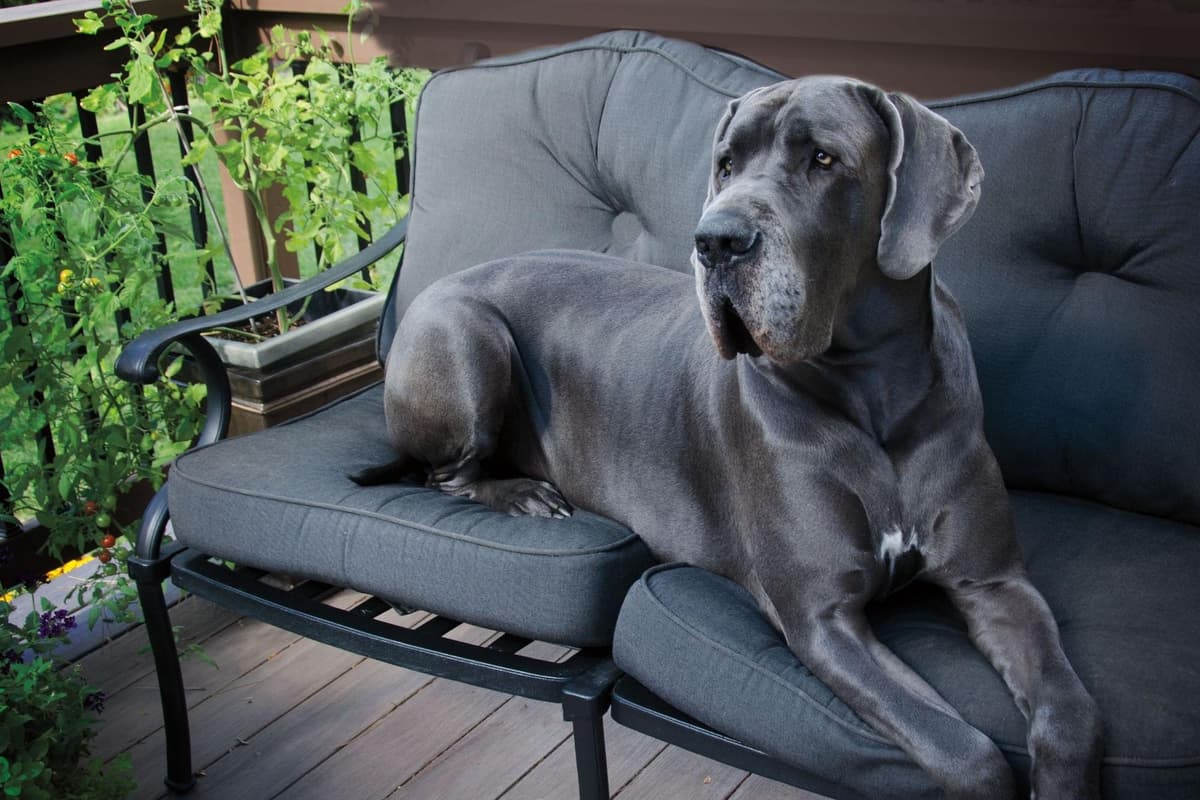
Great Danes are known for their gentle and loving nature despite their large stature. This combination of size and temperament makes them well-suited for family life, as they typically get along well with children and other pets.
We’ll cover several aspects of what makes the Great Dane a true ‘Gentle Giant’:
- Great Danes naturally exhibit a calm and friendly temperament, a defining characteristic of the breed.
- These dogs often thrive in a home setting, where their affectionate nature can shine through in their interactions with family members.
- Training Great Danes can be a rewarding experience, as they are usually eager to please and respond well to positive reinforcement techniques.
- Despite their intimidating appearance, Great Danes are usually consistent in their gentle behavior around children, making their size a lesser concern.
Great Danes are inherently kind creatures. Their serene personality is well-suited for families, and they tend to form strong bonds with their human companions. Their size might be imposing when living with a Great Dane, but their behavior around adults and kids is typically calm and caring. They are known to be patient and protective, which makes them a favored choice for households with children and other animals.
For training these gentle giants, using methods that align with their calm disposition is vital. Positive reinforcement, such as treats and praise, works well with Great Danes, encouraging them to behave appropriately without harsh discipline. Their eagerness to please makes them responsive to such training, helping to maintain their gentle nature.
When it comes to children, Great Danes often show a remarkable level of gentleness and patience despite their towering size. Their ability to remain composed and affectionate around young ones makes them a beloved breed. Supervising interactions between dogs and young children is essential, but with Great Danes, there’s typically an innate sense of care and protectiveness.
Nature of Gentleness
Great Danes are known for their gentle, giant nature, showcasing a warm and loving personality that makes them a hit with families and new people they meet. These dogs have evolved from their original purposes of hunting and protection to become affectionate companions, thanks to careful breeding that favored their friendly traits.
Their calm energy levels mean they’re pretty flexible regarding living spaces, even in apartments, as long as they get enough exercise. Owners must stay alert to health issues like bloat and heart disease, which require regular check-ups to keep these dogs in their best, amiable condition.
Training a Great Dane is usually a breeze when using positive techniques and early socialization, helping them become polite and integrated household members, according to the American Kennel Club.
Interaction With Family
Great Danes are known for their gentle nature and quickly become loving family members. They have a calm and friendly demeanor, which makes them great pets for homes with people of all ages. These dogs are social creatures and get along well with other dogs and different kinds of pets, making them a perfect fit for households with various animals. Great Danes adapt quickly and are typically low-energy, which works well with many family lifestyles.
To ensure they become well-behaved family members, starting socialization and training early is essential, using positive methods that build respect and understanding. A proper diet and consistent care keep a Great Dane’s temperament sweet, contributing to a positive atmosphere in the home.
Training the Gentle Giant
Great Danes are known for their gentle and loving nature, making them perfect family dogs. It’s important to start training them early, using methods that match their peaceful temperament. Positive reinforcement works best for these dogs, supporting their mental health and helping them become well-behaved family members.
Early socialization is critical for Great Danes to help them grow up feeling secure and well-adjusted. Regular check-ups with a vet are also necessary, especially because Great Danes can have health issues like bloat and joint problems. Proper care and training are essential to keep these big dogs happy and healthy.
Behavior Around Children
Great Danes are known for their loving and calm demeanor, which makes them excellent companions for children. These large dogs naturally tend to be tender and protective with kids, demonstrating the ‘gentle giant’ quality they’re famous for. Nevertheless, due to their considerable size, training them early on behaving around children is critical.
Training should involve exposing the dog to various child-related scenarios in a controlled way, which helps build a secure and respectful bond.
Supervising interactions between Great Danes and small children is crucial. This prevents any unintentional harm caused by the dog’s large build and power. Ensuring safety during these interactions is critical for a positive experience for everyone.
Size Vs. Temperament
Great Danes stand tall but remain some of the most affectionate pets. Their size can be misleading, as they are neither hostile nor intimidating. These gentle giants thrive on companionship and are known for their peaceful nature.
Despite their imposing appearance, they prefer a laid-back lifestyle but need plenty of food to fuel their bodies. Great Danes have a low activity level, which is surprising given their size, and they require a lot of food to keep up with their fast metabolism.
To keep their friendly nature, it’s important to socialize and train them early using positive methods. Proper training from a young age is critical to ensuring they become nice and well-behaved dogs, making them great for families, including those with kids, and they are easy to train.
Lifespan and Common Ailments
Great Danes, majestic, tend to live shorter lives than many other dogs, usually around 7 to 10 years. Their size is susceptible to specific health problems, so being proactive in their healthcare is critical. Knowing the typical health issues these dogs face will help owners keep them healthier for longer. Regular vet visits are essential.
Life Expectancy: Great Danes don’t live as long as smaller dogs, often due to genetics. Factors like diet and exercise also play a role.
Health Challenges: These dogs often encounter heart problems, bone and joint conditions, and issues related to their metabolism. Understanding and monitoring these can improve their quality of life.
Care Strategies: Feeding Great Danes smaller, more frequent meals can help prevent gastric issues such as bloat. Consistent health check-ups can catch problems early.
Responsible Breeding: Choosing ethical breeders who prioritize the health of their Great Danes can decrease genetic diseases in the breed. This helps ensure healthier dogs and fewer heartaches for owners.
Average Lifespan Insights
Great Danes often live shorter lives than smaller dog breeds, usually around 7 to 10 years. Their size makes them prone to health issues such as bloat, heart problems, and joint disorders, which can affect both their lifespan and quality of life.
Regular vet visits and a diet made for their needs can help prevent these problems. It is essential to feed them smaller meals more often and use exceptional food for large-breed puppies to reduce the risk of bloat and support healthy growth.
A big, secure yard is also essential for their physical and mental health.
Health Issues Overview
Understanding the health challenges Great Danes face is crucial for their care. These dogs, with an average lifespan of 7 to 10 years, are prone to certain conditions that require proactive health management.
For instance, gastric dilatation volvulus, or bloat, is an emergency that needs immediate veterinary intervention. Regular health checks are also vital to monitor cardiomyopathy, a heart condition affecting these dogs.
A proper diet and regular exercise can help prevent issues like hip dysplasia, a common joint problem in large breeds. Ethical breeding is also vital to reducing the risk of genetic conditions like heart disease and wobbler disease.
Prioritizing these aspects of care can improve the lives of these majestic dogs.
Preventive Care Tips
Adopting a preventive healthcare routine is critical to ensure a long and healthy life for Great Danes. Gastric dilatation-volvulus, or bloat, poses a severe threat but can often be prevented with proper feeding practices. Giving these large dogs multiple meals throughout the day is best to help slow their eating and lower the chances of bloat.
Regular vet check-ups are essential for catching health issues early on. Conditions like hip dysplasia, heart disease, and wobbler syndrome are common in Great Danes and can significantly affect their lifespan if not addressed promptly. Creating a living space for relaxation and moderate exercise will support their joint and heart health.
Puppies, in particular, benefit from a specialized diet formulated for large breeds to prevent bone and joint problems as they grow. Choosing a puppy from a breeder who conducts health screenings can help avoid genetic diseases.
Grooming Requirements
Caring for a Great Dane involves a straightforward grooming routine vital for their health. These large dogs benefit from a few essential practices.
Brushing their coat regularly helps minimize shedding and keeps their skin healthy. It’s good to set a schedule, perhaps touching twice a week.
It’s unnecessary to bathe them too often when it comes to baths. Doing so can strip their skin of natural oils. Generally, a bath every 18 months is sufficient unless they get filthy.
Nail care is also essential for a Great Dane. Keeping their nails short will save your floors and prevent your dog from experiencing discomfort when walking.
As for their ears, regular inspection and cleaning will help prevent infections and remove any dirt or wax buildup.
Sticking to these simple steps can keep your Great Dane looking good and feeling great.
Remember to use the right tools and products for each task to make grooming effective and comfortable for your dog.
Brushing Frequency
To keep your Great Dane’s coat shiny and healthy, brushing once a week is a good rule of thumb. It’s not just about looking good; brushing spreads the dog’s skin oils and cuts down on shedding.
Great Danes are large and graceful, staying that way with proper coat care. Brushing removes dirt and loose hair and massages the skin to keep hair follicles in good shape.
When Great Danes shed more, usually twice a year, you’ll want to brush them more often to keep their coat smooth and prevent tangles. Grooming is also the perfect time to check your dog for skin issues. Catching problems early means they can be treated immediately, which is critical to your dog’s health.
Bathing Practices
Great Danes must bathe every 6 to 8 weeks to keep their coats healthy and clean. Use shampoos made for big dogs to help prevent skin problems. These gentle products help keep the skin’s natural oils, which makes the coat shiny and robust. It’s vital to rinse the dog sufficiently to stop soap from irritating the skin. After a bath, dry the Great Dane’s skin folds around the neck and face properly to keep bacteria and infections away. Ears must be dried thoroughly, too, to stop ear infections. Regular grooming and careful bathing help keep these large dogs healthy.
Washing Great Danes isn’t just about keeping them clean; it’s about their health. The proper bathing routine with the right products can prevent skin issues. This breed’s skin is delicate, so it’s essential to use a mild dog wash that keeps the coat looking good without irritating. Rinsing thoroughly ensures no soap is left behind, which could irritate the skin. After baths, focus on drying the areas where moisture can hide, like the neck and face folds, and don’t forget the ears. Good grooming habits and the proper bathing schedule are critical to a Great Dane’s well-being.
Nail Trimming Essentials
Maintaining short nails is crucial for a Great Dane’s health and comfort. If their nails get too long, these large dogs can suffer from pain and even issues with their posture and bones. The right time to trim a Great Dane’s nails depends on how fast they grow and how much the dog walks or runs.
Long nails can cause a dog to have a spread-out foot stance, which can mess up the proper positioning of their legs. This is especially troublesome for Great Danes because their size puts much pressure on their joints.
When trimming a Great Dane’s nails, it’s essential to be careful not to cut the quick, which is the sensitive part inside the nail. Cutting it can cause bleeding and pain. Using the right tools and a consistent schedule will help keep a Great Dane’s paws healthy.
This will contribute to the dog’s overall physical well-being.
Ear Cleaning Routine
Maintaining the hearing health of a Great Dane requires a regular ear-cleaning routine as part of the dog’s overall grooming. Great Danes are large dogs, and every aspect of their care, including grooming, needs careful attention to prevent potential health problems.
Checking the ears regularly for signs of dirt or wax is essential to avoid infections. Use a vet-recommended ear cleaner and gently wipe the outer ear canal with cotton balls, careful not to touch the eardrum. The ear flaps and nearby folds should be cleaned with a damp cloth to remove accumulated dirt.
It’s important not to poke deep into the ear canal and to see a vet if there are signs of infection like redness, swelling, or foul odor.
Coat Health Tips
Regular grooming must keep a Great Dane’s coat in top condition. This breed’s short fur benefits from frequent brushing to help spread the skin’s natural oils, giving the coat a healthy shine and minimizing hair loss. When it’s time for a bath, use a gentle shampoo and dry the skin folds thoroughly to avoid skin problems.
Since Great Danes love to chase, they’re often more active outdoors, so checking them for ticks and fleas after playtime is essential. Keeping their nails trimmed is also vital for their posture and movement.
It’s wise to use professional groomers and schedule regular vet check-ups to catch skin issues or parasites early on.
Pet Parents Dietary Recommendations
Designing a balanced diet for a Great Dane requires careful consideration of their specific dietary needs. When met, these large dogs have particular requirements that can support their overall health and help prevent common breed-related issues.
Here’s a breakdown of what to focus on when feeding an estate Great Dane:
- Nutritional Balance: It’s essential to check the balance of proteins, fats, carbohydrates, vitamins, and minerals in your Great Dane’s diet. These nutrients support their growth, energy levels, and overall health.
- Meal Timing: Regular meal times and appropriate portions are essential to maintain your Great Dane’s digestive health and energy. Overfeeding or feeding at irregular intervals can lead to bloat, a severe condition for this breed.
- Specialized Diets: If your Great Dane has specific health issues like allergies or joint problems, you might need to adjust their diet accordingly. This could include limited-ingredient foods or diets formulated for sensitive stomachs.
- Supplements: Supplements like glucosamine can benefit joint health depending on your dog’s health and lifestyle. However, always consult a veterinarian before adding supplements to your dog’s diet.
Nutritional Needs
Catering to the specific dietary needs of Great Danes is critical for their well-being, given their fast metabolism and the health issues they’re prone to. These large dogs need more food per pound of body weight than smaller breeds to match their quick metabolic rate. To prevent bloat, a dangerous condition, it’s recommended to feed them smaller portions throughout the day and let them rest after eating. Great Danes also have a higher risk of heart conditions like dilated cardiomyopathy, as well as joint problems like hip dysplasia. Therefore, their diet must have the proper heart and bone health nutrients.
While responsible breeding can help reduce health problems, regular vet check-ups and a diet that promotes heart and joint health are critical to a Great Dane’s long life.
Caring for Great Danes means being proactive about their meals and health. Smaller, more regular feedings can help avoid bloat, and rest after eating is necessary to let their digestion work properly. Since these dogs can suffer from heart and joint issues, their food should include specific nutrients that bolster cardiac function and bone strength.
While good breeding helps, nothing replaces consistent vet care and a nutritionally balanced diet to keep these dogs healthy for years.
Feeding Schedules
Understanding the specific needs of Great Danes is crucial for their health and well-being. These large dogs need more energy and food relative to their size than smaller breeds, so their diet must be carefully managed. To reduce the risk of bloat, a serious health issue, it’s best to feed them smaller meals throughout the day and ensure they rest after eating.
For growing puppies of this breed, it’s recommended to feed them food formulated for large breeds, which supports proper bone development and helps prevent conditions such as hip dysplasia. A thoughtful feeding plan should also consider ways to reduce the risk of heart conditions like dilated cardiomyopathy and spinal issues like wobbler disease.
Health-Specific Diets
Great Danes have specific dietary needs to stay healthy and avoid common breed-related health issues. These large dogs have a quick metabolism and are prone to severe conditions like bloat and heart problems. To match their rapid calorie burning, Great Danes need more food relative to their size than smaller breeds. It is essential to provide them with a well-balanced diet that supports their growth and day-to-day energy requirements.
To reduce the risk of bloat, which can be fatal, it’s better to give Great Danes several smaller meals throughout the day rather than one large one. Choosing foods that promote heart health is also vital to decrease the likelihood of them developing dilated cardiomyopathy, a common heart condition in the breed. Responsible breeders and continuous vet care through regular check-ups and diet adjustments are crucial in maintaining the health of these dogs.
